The Samsung Galaxy S21 Ultra & S21 Review: The Near Perfect and The Different
by Andrei Frumusanu on February 22, 2021 12:00 PM EST- Posted in
- Smartphones
- Samsung
- Mobile
- Galaxy S21
- Galaxy S21 Ultra
Display Measurement
We’ve noted many times now that the displays of the S21 series are relatively special, although for different reasons depending on the model.
The S21 Ultra’s new panel uses a new hybrid oxide pack panel technology along with a new OLED emitter generation that allows it offer seamless fine-grained refresh rate switching along with getting extremely bright while being much more power efficient. The smaller S21 doesn’t have any of the new display technologies, it is lower resolution, but still has software based adaptive frequency features. I did note that at least in terms of hardware build quality, the smaller S21 does seem to have advantages over the S20 series when it comes to its lamination, as I am seeing better viewing angles, and the panel being better glued to the glass.
When it comes to colour accuracy, we find Samsung’s usual display modes, limited to a “Vivid” setting that’s more saturated in terms of the colours, and allows you to fine-tune colour temperature to your taste, and the “Natural” screen mode that tries to adhere to sRGB and Display P3 colour gamuts and features near 6500K whites.
We move on to the display calibration and fundamental display measurements of the Galaxy S21 Ultra and S21 screens. As always, we thank X-Rite and SpecraCal, as our measurements are performed with an X-Rite i1Pro 2 spectrophotometer, with the exception of black levels which are measured with an i1Display Pro colorimeter. Data is collected and examined using Portrait Display's CalMAN software.

When it comes to screen brightness, the Galaxy S21 isn’t all much different to the S20 series, although it does allow for brighter manual brightness up to 393 nits on our unit. Peak full screen whites are still at around 700 nits when in auto-brightness mode under bright ambient conditions.
The S21 Ultra’s brightness is beyond any other OLED display on the market right now. Manual brightness is still limited by Samsung to only 462 nits, however when in auto-brightness, it goes to a staggering 942 nits – almost beating the superbly bright RGBW LCD display of the LG G7.
If you’re looking for a device which does excellently under sunlight, then the S21 Ultra is definitely the right choice.
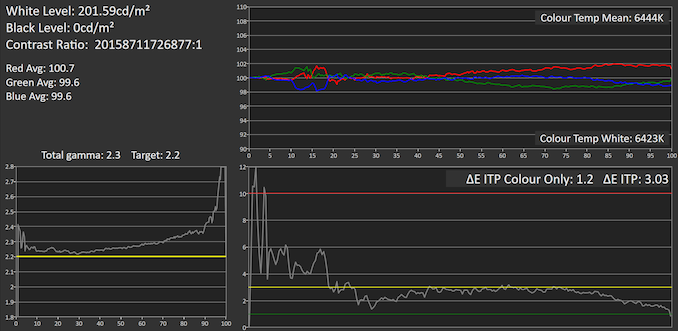
 Portrait Displays CalMAN
Portrait Displays CalMAN
Galaxy S21 Ultra
In terms of greyscale accuracy, the good news for this generation is that it seems Samsung has done a better job than in past years. Whites fall in at 6423K on the S21 Ultra, much less red than the S20 series devices’ calibration, with general great colour balance at dEITP of only 1.2. Gamma curve also looks reasonable although it’s still hard to measure this accurately due to Samsung’s APL brightness adjustments, even with fixed 50 APL and 50% windows sizes during out measurements.
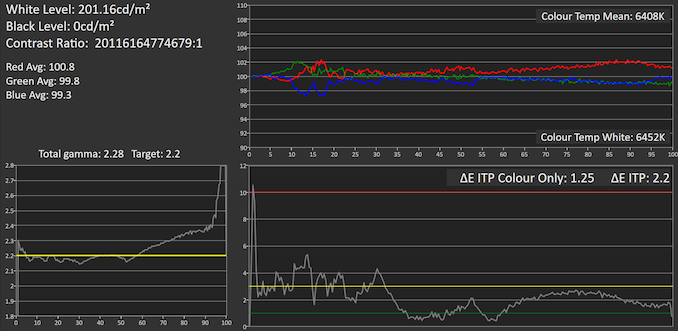
 Portrait Displays CalMAN
Portrait Displays CalMAN
Galaxy S21
The smaller Galaxy S21 also does very well, with great colour temperature out of the box .
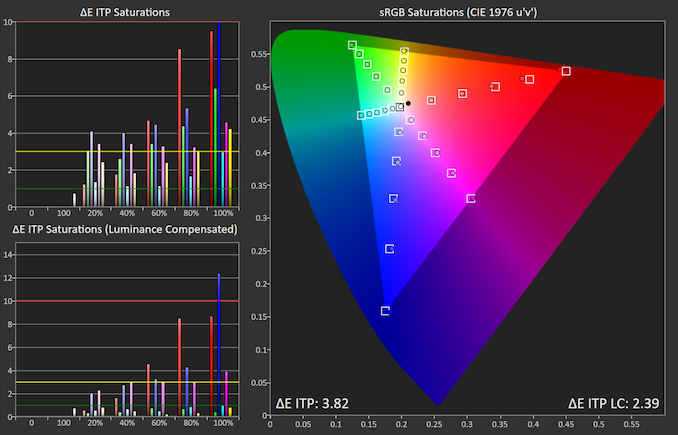 Portrait Displays CalMAN
Portrait Displays CalMAN
Galaxy S21 Ultra
Saturation accuracy on the S21 Ultra is great in all aspects except the reds, which for some reason are undersaturated at the maximum intensities.
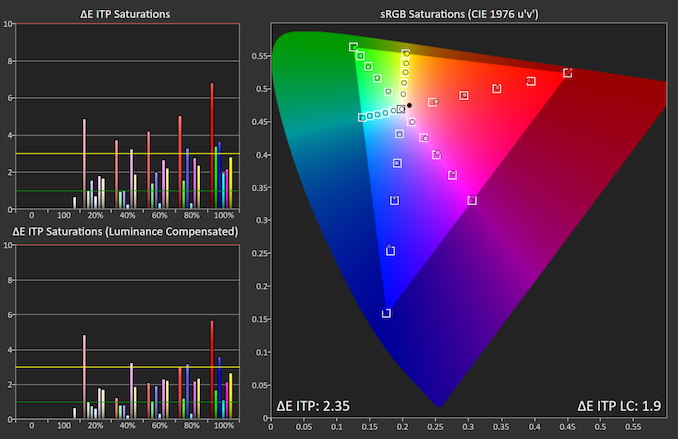 Portrait Displays CalMAN
Portrait Displays CalMAN
Galaxy S21
The smaller S21 doesn’t have the same issue, showcasing generally more accurate colours.

 Portrait Displays CalMAN
Portrait Displays CalMAN
Galaxy S21 Ultra
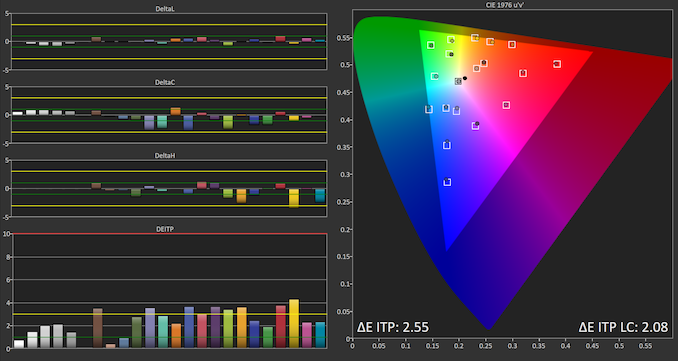
 Portrait Displays CalMAN
Portrait Displays CalMAN
Galaxy S21
Gretag MacBeth test patches with common colours such as skin tones fare well for both the S21 Ultra as well as the S21, although the latter does better, showcasing less luminosity errors.
Overall, Samsung did uncharacteristically well this year when it comes to colour accuracy. After a few years of glaring gamma issues and too warm whites, the S21 series seems to be able to achieve great results out of the box, early on in its firmware, which couldn’t be said of the S10 or S20 series.
The S21 Ultra’s display in terms of its fundamentals is outstanding – it gets extremely bright, more than any other phone in the market right now. Together with the 1440p resolution and 120Hz refresh rate, it represents the single best mobile display in the industry right now.
The smaller S21 display is good, although really not in the same class as the Ultra’s panel. There’s really nothing much to write home about here, as it’s very much similar to many other 1080p panels in the industry, with good brightness levels, good colour accuracy, and of course also featuring that 120Hz adaptive refresh rate mode. If the Ultra’s panel is an S-tier display, the baseline model’s display is A-tier.


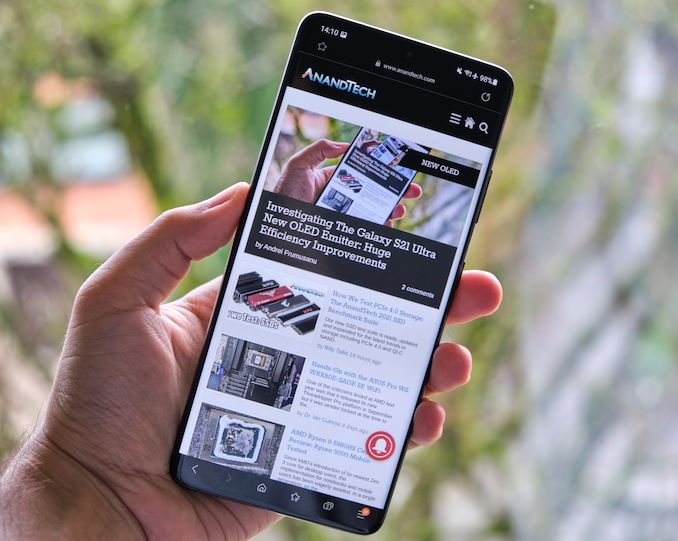








122 Comments
View All Comments
Silver5urfer - Wednesday, February 24, 2021 - link
Mass market just mindlessley consumes. Remember that Android had Windows like Filesystem which was the most powerful feature ever on smartphone. Google killed it in the name of Security. Esp all the images that you download on these latest Android 10+ phones, you cannot see any image or file under fileexplorer because its in the app own folder and once you uninstall all of it is wiped clean. It's ultimate kick in the gut for Android. On top no MicroSD card.But it's all great, because it looks good ? not to me anyways with that ugly screen hole and bump of camera module. It's great because it's the trend nowadays. These stupid smartphones are ruining more than anything with their social media junkware and addiction to teens all over the world and have some status quo as well.
AT should have done some great deep dive on how OS is getting sandbagged to emulate and copy Apple in HW and SW but they do not give a shit. It's all spec benchmarks, Camera. Not even damn cost, not even specifications get pointed out. Fucking $1000 phone with plastic ? What the hell ? No charger as well, they even axed MST.
But nope. It's a great device, tmrw Apple will kill Lighting port, you will see AT praise It's the future along with all Shills on youtube and other so called tech blogs.
Windows is also sadly in a state of perpetual derangement, with it's as a service model bullcrap and their anti computing, they shove all that touch based garbage UWP UI into Win32 and pollute the UX of Windows as a powerful Desktop OS to a sandbagged corporate siphon for data on userbase and ship broken trash and use them as guinea pigs to push stable software for Win10 Enterprise customers.
JoeDuarte - Thursday, February 25, 2021 - link
I think that locking down the file system is a good and obvious security move, though it shouldn't come at any cost to the user. There should be obvious folders for things like photos, and those should not be cleaned out by uninstalling an app.Google is a hopelessly bad company at this point though, and I would never trust them to design a good OS. They're not good enough, and they're just enjoying their market share because no one seems interested in launching a new OS, for mobile or more broadly.
OSes could and should be massively more secure. It's a dimwitted myth that computers have to be insecure. If I were designing an OS, the user wouldn't know anything about a "file system" and there's no way anyone would be able to see system/OS folders and files. That's a huge information security leak. Of course apps would have no awareness of the system directory tree either. In fact, I might even physically isolate the OS on its own flash storage – a little 16 GiB of NAND or Optane would be more than ample. It could have all sorts of layered security measures, in software and hardware.
I'd give users enormous control over things like their files, photos, etc. More user-friendly than Android for sure. But they don't need access to OS innards, and they don't need the "file system" abstraction – it doesn't add any value to the UX. Entire categories of Windows exploits would disappear if users didn't have access to system folders.
iphonebestgamephone - Friday, February 26, 2021 - link
So no modding on your os?JoeDuarte - Wednesday, March 3, 2021 - link
Good question. I guess I lean toward yes, it would be possible to mod. Maybe something like a Developer Mode would be the way to implement it. If the file system is locked down, and OS files are locked down, by default for non-modding users, that should be good enough to obtain the security benefits in terms of exploit resistance.Exploits would be much less important if 9X% of users were immune. Well even modded systems would be immune to the sorts of exploits that are common now, all the memory bugs, overflows, use after frees, ROP, etc. A good OS would be formally verified (like seL4) and written in a new, advanced, and inherently secure programming language (secure against memory bugs, among other things). So I think modding would be cool, and I also think any desktop and laptop should be thoroughly upgradeable on the hardware side, so removable SSDs and RAM and maybe FPGA slots. I'm fine with non-upgradeable phones, but it would be sweet if they could achieve the same or better thinness while having a removable battery. Non-removable batteries don't seem to have given the use any benefits in terms of thinness, since the phones didn't get thinner. If anything, they're slightly thicker now, which is a shame, and I think the tech media has underexposed this fact – there was no benefit. And iPhones didn't get any thinner from removing the headphone port, which was supposed to be motivated by space savings. The media didn't seem to notice that the thickness didn't change...
iphonebestgamephone - Friday, March 5, 2021 - link
Ok thenRude Russy - Tuesday, March 9, 2021 - link
Wow you are a miserable shit and you don't know what you are talking about. As for the headphones all you have to do is get a usb-c adaptor and you can plug your headphones in.tuxRoller - Wednesday, February 24, 2021 - link
Has the huawei always used such strong edge detection/enhancing?Some of the shots bring to mind me an aggressive comic inker.
s.yu - Thursday, February 25, 2021 - link
Huawei is back and forth on this issue, generally the Mates are better and the P's are worse, IIRC P20 was the worst I've ever seen, but in the scope of this review my attention was on the Samsungs' tele samples.asfletch - Wednesday, February 24, 2021 - link
Just wanted to chime in to thank you for the hard work you put into these reviews Andrei. The comments section seems to be increasingly grievance-driven and glib these days, but as a long time reader I appreciate that you’re still able to provide more technical detail than most other reviewers despite not having a huge budget (eg to purchase and spend forever testing every variant).To those moaning about video testing, Youtube is a better forum for that kind of thing anyway. You won’t find in depth screen or platform analyses on there though.
Giro - Wednesday, February 24, 2021 - link
Hello Andrei, thanks A LOT for this comprehensive review.It seems you consider Huawei like the reference for low light AND use of a better set-up for intermediate levels of zoom.
Regardless of the OS, where Huawei falls behind Samsung now ?